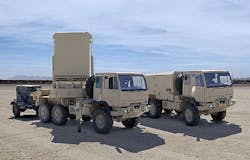Army asks Lockheed Martin to upgrade AN/TPQ-53 air-defense radar with counter-drone capability
Officials of the U.S. Army Contracting Command at Aberdeen Proving Ground, Md., announced a $27.8 million contract Wednesday to the Lockheed Martin Rotary and Mission Systems segment in Syracuse, N.Y., to add counter-unmanned aerial system (C-UAS) capability to the AN/TPQ-53 radar.
Now Army experts are asking Lockheed Martin to make software upgrades to the AN/TPQ-53 to enhance its reliability against enemy drones and other unmanned aircraft, as well as integrate an off-the-shelf identification-friend-or-foe (IFF) subsystem to the radar.
The so-called Q-53 -- designed and built by Lockheed Martin Rotary and Mission Systems -- is a solid-state phased array radar that detects, classifies, tracks, and determines the location of enemy indirect fire weapons like rockets, artillery shells, and mortars in either 360- or 90-degree modes. This system is replacing the aging U.S. Army AN/TPQ-36 and AN/TPQ-37 medium-range radars.
The AN/TPQ-53 radar is the U.S. Army's standard forward-deployed system for long-range surveillance and tracking radar against rockets, artillery, and mortar threats for brigade combat teams. Lockheed Martin builds the Q-53 radar in Syracuse and Owego, N.Y.; Moorestown, N.J.; and Clearwater, Fla.
The Q-53 radar is deployed on an Army 5-ton FMTV truck, and can go into battle with heavy, medium, and light forces. A second tactical truck carries an operations control shelter, backup power generator, and two additional soldiers to operate the system.
Lockheed Martin officials say they expect th Army to award a full-rate production contract for the Q-53 this year or next. Company experts have been making incremental improvements to the new radar to improve to increase its counter fire radar flexibilities. Lockheed Martin started developing the Q-53 counter-fire radar in 2007.
Last July Lockheed Martin won a $4.1 million contract from the U.S. Defense Microelectronics Activity (DMEA) in McClellan Park, Calif., to upgrade electronic components in the AN/TPQ-53 to increase its accuracy in high radar clutter, decrease its false location rate, as well as improve its probability of location and probability of correct classification. Lockheed Martin is correcting system anomalies detected during testing and during live operations.
The AN/TPQ-53 is designed to detect the firing points of enemy mortars, artillery shells, and rockets with sufficient accuracy to enable counter-fire that will destroy the enemy launcher with one shot.
The Q-53 is deployable as part of the Counter-Rocket Artillery and Mortar (C-RAM) system of systems (SoS) to provide a sense and warn capability for deployed U.S. and allied forces. The system is small enough to move aboard C-130 and C-17 aircraft.
story continues below
To upgrade the radar to detect and track enemy drones, Lock heed Martin will modify the existing AN/TPQ-53 software to detect, track and identify enemy drones hindering existing waveforms for detection and tracking.
The goal is to integrate these upgraded counter-drone capabilities with minimal hardware modification and no increase to manpower requirements of the existing AN/TPQ-53 system.
In addition, Lockheed Martin will modify existing AN/TPQ-53 software interfaces to the Army's Advanced Field Artillery Tactical Data System (AFATDS) and Forward Area Air Defense Command and Control (FAAD C2) system to provide enemy drone information to counter-fire batteries.
Lockheed Martin will demonstrate the upgraded AN/TPQ-53 radar with counter-drone capabilities during Army field exercises in January and June 2017, and will provide the final fieldable configuration for assessment in January 2018. The final fieldable system should be ready by June 2018.
On this contract Lockheed Martin will do the work in Syracuse, N.Y., and should be finished by 2018. For more information contact Lockheed Martin Rotary and Mission Systems online at www.lockheedmartin.com/us/rms.html, or the Army Contracting Command at Aberdeen Proving Ground at www.acc.army.mil/contractingcenters/acc-apg.
Learn more: search the Aerospace & Defense Buyer's Guide for companies, new products, press releases, and videos
